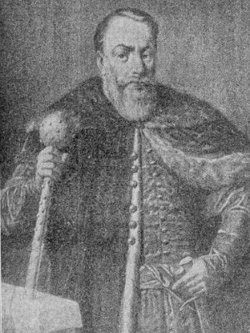Jan Karol Chodkiewicz
|
|
| Jan Karol Chodkiewicz | |
|
| |
| Noble Family | Chodkiewicz |
| Coat of Arms | Chodkiewicz |
| Parents | Jan Hieronim Chodkiewicz Krystyna Zborowska |
| Consorts | Zofia Mielecka Anna Alojza Ostrogska |
| Children | with Zofia Mielecka Hieronim Chodkiewicz Anna Scholastyka Chodkiewicz |
| Date of Birth | 1560 |
| Place of Birth | ? |
| Date of Death | September 24, 1621 |
| Place of Death | Chocim Castle, Poland |
Jan Karol Chodkiewicz (1560-September 24 1621) was a famous Polish military commander (Field and Great Lithuanian Hetman) and one of the most prominent szlachcic of the 17th century in Polish-Lithuanian Commonwealth. Great military commander.
Biography
He was the son of Hieronymus Chodkiewicz, Ruthenian castellan of Wilno (now Vilnius). After being educated at the Wilno University he went abroad to learn the science of war, fighting in the Spanish service under Alva, and also under Maurice of Nassau. In 1593 he married the wealthy Sophia Mielecka, by whom he had one son who predeceased him. His first military service in Poland was against the Cossack uprising of Nalewajko as lieutenant to hetman Stanislaw Zolkiewski, and he subsequently assisted Jan Zamojski in his victorious Moldavian campaign.
Herb_Jan_Karol_Chodkiewicz.jpg
Honours and dignities were now showered upon him. In 1599 he was appointed starosta of Samogitia, and in 1600 acting commander-in-chief of Lithuania.
Chodkiewicz's first claim to fame were his victories in 1600 during the Moldavian Magnate Wars, where he defeated Turks and their allies, serving under the command of hetman Jan Zamoyski. A year later, in 1601, he accompanied Zamoyski north, to Lithuania. In the war against Sweden for possession of Livonia he was appointed acting commander in chief of Lithuania after Zamoyski's return to Crown in 1602. Chodkiewicz, despite inadequate supplies and little support from the Commonwealth Sejm (parliament) and King Sigismund III, brilliantly distinguished himself, capturing fortress after fortress and repulsing the duke of Sudermannia, afterwards Charles IX, from Riga. In 1604 he captured Dorpat (Tartu), twice defeated the Swedish generals at Bialy Kamien and near Weissenstein in 1604, and was rewarded with the grand baton of Lithuania. Criminally neglected by the diet, which turned a deaf ear to all his requests for reinforcements and for supplies and money to pay his soldiers, Chodkiewicz nevertheless more than held his own against the Swedes. His crowning achievement was the great victory near the Dvina River in the Battle of Kircholm (Salaspils) on September 27th, 1605, when with barely 5000 hussars he annihilated a threefold larger Swedish army; for which feat he received letters of congratulation from the pope, all the Catholic potentates of Europe, and even from the sultan of Turkey and the shah of Persia.
Yet this great victory was absolutely fruitless, owing to the domestic dissensions which prevailed in the Commonwealth during the following five years. Chodkiewicz's own army, unpaid for years, abandoned him at last en masse in order to plunder the estates of their political opponents, leaving the hetman to carry on the war as best as he could with a handful of mercenaries paid out of the pockets of himself and his friends. Chodkiewicz was one of the few magnates who remained loyal to the king, and after helping to defeat the rebels (rokosz) in 1606-1607 in Poland, a fresh invasion of Livonia by the Swedes recalled him thither, and in 1609 once more he relieved Riga besides capturing Pernau.
Hetman_Chodkiewicz.jpg
Meanwhile the war with Russia broke out (the Dimitriads wars), and Chodkiewicz was sent against Moscow with an army of 2000 men. Moreover, the diet neglected to pay for the maintenance even of this paltry 2000, with the result, that they mutinied and compelled their leader to retreat through the heart of Russia to Smolensk. Not till the crown prince, Władysław arrived with tardy reinforcements did the war assume a different character, Chodkiewicz opening a new career of victory by taking the fortress of Drohobycz (Dorohobuzh) in 1617. During that campaign, among many officers under Chodkiewicz's command, was future hetman, Stanislaw Koniecpolski.
The Dimitriads had no sooner been ended by the treaty of Deulino than Chodkiewicz was hastily dispatched southwards to defend the southern frontier against the Turks, who after their victory at the Cecora had high hopes of conquering Poland altogether. An army of 160,000 Turkish veterans led by Sultan Osman II in person advanced from Adrianople towards the Polish frontier, but Chodkiewicz crossed the Dnieper in September 1621 and entrenched himself in the fortress of Chocim right in the path of the Ottoman advance. Here for a whole month the Commonwealth hetman held the sultan at bay, till the first fall of autumn snow compelled Osman to withdraw his diminished forces. But the victory was dearly purchased by Poland. A few days before the siege was raised the aged grand hetman died of exhaustion in the fortress on September 24, 1621.
References
Template:Hetmans GL Template:Hetmans FLbe:Ян Караль Хадкевіч pl:Jan Karol Chodkiewicz

